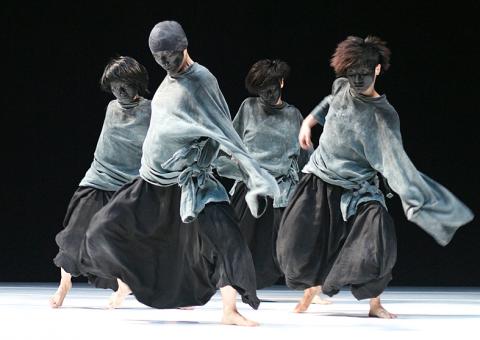The TAO Dance Theater (陶身體劇場) is a small company, but it certainly packs a big punch, having developed a major reputation both in China and internationally in just a few years.
The Beijing-based troupe, founded in March 2008 by dancers Tao Ye (陶冶) and Wang Hao (王好), is making its long-delayed Taipei premiere this weekend at Novel Hall as part of the Novel Hall Dance Series.
The company was supposed to have performed at Novel 15 months ago, but an injury to one of its dancers forced the troupe to pull out of the 2012 series. However, the upside to the delay is that Tao has brought his latest work, 6, which was commissioned for the opening of the 2014 European Capital of Culture in Umea, Sweden.

Photo Courtesy of Fax Xi/ TAO Dance Theater
Tonight’s program features 2 and 4, while tomorrow night’s performances include 5 and 6. The titles refer to the number of dancers in each work.
Tao has been quoted in interviews as saying that titles are limiting because they create preconceptions that limit both creative direction and the audience’s imagination. However, using a symbol or a number helps combine the abstract with the concrete, he said. Plus, since numbers can extend to infinity, it means his works can be read as a chronology of his life.
His work is very modern and abstract, but it defies genres. While Tao received a solid grounding in traditional Chinese dance as well as ballet at the Chongqing Dance School, training he put to good use as a performer in the Shanghai Army Song & Dance Ensemble and then the contemporary Jin Xing Dance Theater in Shanghai, and the Beijing Modern Dance Company.
In 2, two dancers appear to be battling a magnetic force that is pulling them toward the ground; it is also a struggle between motion and non-motion. The piece is set to a soundscape by frequent collaborator, the indie composer Xiao He (小河), as are the other works on the program, who incorporates the piano, guitar, voice and environmental sounds into his compositions.
In 4, a magnetic wave appears to be driving the movements of the four dancers, who flow like water, coming together and then parting, but never touching.
In 5, the focus is on touching. The five dancers do not move as one, but as a constantly morphing mass, rolling around on the floor.
For 6, Tao combined Xiao He’s music with the traditional singing of the Sami people of Scandinavia.

May 26 to June 1 When the Qing Dynasty first took control over many parts of Taiwan in 1684, it roughly continued the Kingdom of Tungning’s administrative borders (see below), setting up one prefecture and three counties. The actual area of control covered today’s Chiayi, Tainan and Kaohsiung. The administrative center was in Taiwan Prefecture, in today’s Tainan. But as Han settlement expanded and due to rebellions and other international incidents, the administrative units became more complex. By the time Taiwan became a province of the Qing in 1887, there were three prefectures, eleven counties, three subprefectures and one directly-administered prefecture, with

It’s an enormous dome of colorful glass, something between the Sistine Chapel and a Marc Chagall fresco. And yet, it’s just a subway station. Formosa Boulevard is the heart of Kaohsiung’s mass transit system. In metro terms, it’s modest: the only transfer station in a network with just two lines. But it’s a landmark nonetheless: a civic space that serves as much more than a point of transit. On a hot Sunday, the corridors and vast halls are filled with a market selling everything from second-hand clothes to toys and house decorations. It’s just one of the many events the station hosts,

Two moves show Taichung Mayor Lu Shiow-yen (盧秀燕) is gunning for Chinese Nationalist Party (KMT) party chair and the 2028 presidential election. Technically, these are not yet “officially” official, but by the rules of Taiwan politics, she is now on the dance floor. Earlier this month Lu confirmed in an interview in Japan’s Nikkei that she was considering running for KMT chair. This is not new news, but according to reports from her camp she previously was still considering the case for and against running. By choosing a respected, international news outlet, she declared it to the world. While the outside world

Through art and storytelling, La Benida Hui empowers children to become environmental heroes, using everything from SpongeBob to microorganisms to reimagine their relationship with nature. “I tell the students that they have superpowers. It needs to be emphasized that their choices can make a difference,” says Hui, an environmental artist and education specialist. For her second year as Badou Elementary’s artist in residence, Hui leads creative lessons on environmental protection, where students reflect on their relationship with nature and transform beach waste into artworks. Standing in lush green hills overlooking the ocean with land extending into the intertidal zone, the school in Keelung